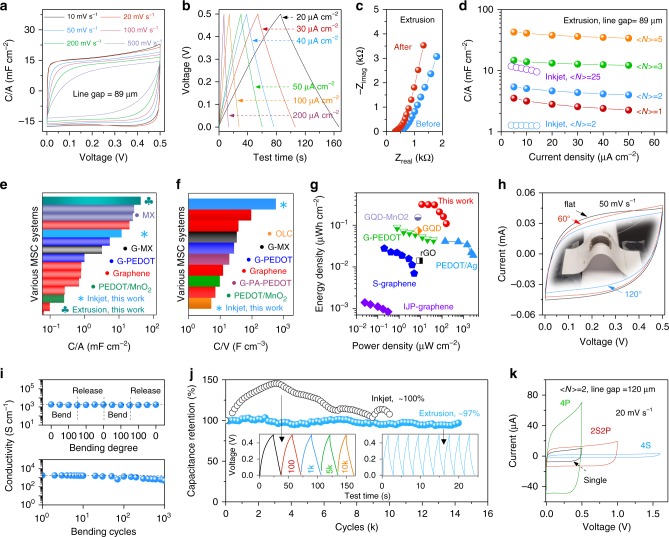Fig. 5.
Electrochemical response of inkjet- and extrusion-printed MXene MSCs. a Normalized cyclic voltammograms (CV) profiles and b galvanostatic charge–discharge (GCD) curves of a typical extrusion-printed MSC (line gap ~89 µm, <N> = 3). c Electrochemical impedance spectroscopy of extrusion-printed MSC before and after the CV tests at various scan rates. d Areal capacitance of inkjet- and extrusion-printed MSCs with different <N>. An areal capacitance of 1.3 and 12 mF cm−2 is achieved with inkjet printing of <N> = 2 and 25, respectively. e Areal capacitance (C/A) and f volumetric capacitance (C/V) comparison of this work to other reported MSC systems, showing much higher C/V of our printed MXene MSCs than other reports. g Ragone plot comparison of this work (extrusion-printed MSC with <N> = 5) to other MSC systems. Detailed references and specific values in (e)–(g) can be found in the Supplementary Information (Supplementary Table 2–4). h CVs of extrusion-printed MSC supported on a paper substrate (inset) under different bending degrees. i Electronic conductivity of the extrusion-printed lines plotted as a function of bending degree (top) and bending cycles (bottom). j Long-term cycling of inkjet- and extrusion-printed MSCs with current densities of 14 and 200 µA cm−2, respectively. Insets are the typical GCD curves, showing capacitive behaviour during cycling, indicating that the excellent electrochemical performance is not due to parasitic reactions. k Typical CV curves of the as-printed tandem devices, such as printing four MSCs in series and in parallel, and two in series and in parallel. The as-formed tandem devices exhibit capacitive responses, showing the great flexibility of this approach to satisfy different energy/power demands

